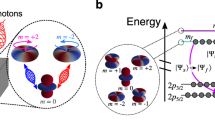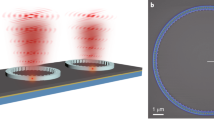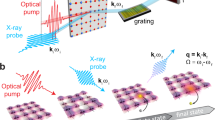Abstract
Light’s capacity to carry angular momentum is integral to our knowledge of physics and ability to probe matter. In addition to spin, photons can occupy free-space orbital angular momentum eigenstates1,2. Visible light orbital angular momentum is used in quantum information experiments, super-resolution microscopy, optical tweezers and angular momentum transfer to atoms in optical lattices3,4. Soft X-ray orbital angular momentum applications, slowed by the lack of suitable optics and the rarity of coherent X-ray sources, could enable the direct alteration of atomic states through orbital angular momentum exchange, and methods to study the electronic properties of quantum materials. We have made soft X-ray diffractive optics that generate single Laguerre–Gauss modes, observed carrying up to 30ħ angular momentum per photon, or their superpositions. We also present Hermite–Gauss diffractive optics and a soft X-ray orbital angular momentum analyser. These tools could enable both the manipulation and finer characterization of topologically complex electronic matter, such as magnetic skyrmions.
This is a preview of subscription content, access via your institution
Access options
Access Nature and 54 other Nature Portfolio journals
Get Nature+, our best-value online-access subscription
$29.99 / 30 days
cancel any time
Subscribe to this journal
Receive 12 print issues and online access
$209.00 per year
only $17.42 per issue
Buy this article
- Purchase on Springer Link
- Instant access to full article PDF
Prices may be subject to local taxes which are calculated during checkout




Similar content being viewed by others
Data availability
The data that support the plots within this paper and other findings of this study are available from J.C.T.L. (lee216@illinois.edu) and/or the corresponding author upon reasonable request.
References
Allen, L., Beijersbergen, M. W., Spreeuw, R. J. C. & Woerdman, J. P. Orbital angular momentum of light and the transformation of Laguerre–Gaussian laser modes. Phys. Rev. A 45, 8185–8189 (1992).
Allen, L., Padgett, M. & Babiker, M. IV The orbital angular momentum of light. Progr. Opt. 39, 291–372 (1999).
Franke-Arnold, S., Allen, L. & Padgett, M. Advances in optical angular momentum. Laser Photon. Rev. 2, 299–313 (2008).
Hell, S. W. & Wichmann, J. Breaking the diffraction resolution limit by stimulated emission: stimulated-emission–depletion fluorescence microscopy. Opt. Lett. 19, 780–782 (1994).
Gariepy, G. et al. Creating high-harmonic beams with controlled orbital angular momentum. Phys. Rev. Lett. 113, 153901 (2014).
Géneaux, R. et al. Synthesis and characterization of attosecond light vortices in the extreme ultraviolet. Nat. Commun. 7, 12583 (2016).
Kong, F. et al. Controlling the orbital angular momentum of high harmonic vortices. Nat. Commun. 8, 14970 (2017).
Bahrdt, J. et al. First observation of photons carrying orbital angular momentum in undulator radiation. Phys. Rev. Lett. 111, 034801 (2013).
Hemsing, E. et al. Coherent optical vortices from relativistic electron beams. Nat. Phys. 9, 549–553 (2013).
Rebernik Ribič, P. et al. Extreme-ultraviolet vortices from a free-electron laser. Phys. Rev. X 7, 031036 (2017).
Hernández-García, C. et al. Generation and applications of extreme-ultraviolet vortices. Photonics 4, 28 (2017).
Peele, A. G. et al. Observation of an X-ray vortex. Opt. Lett. 27, 1752–1754 (2002).
Vila-Comamala, J., Sakdinawat, A. & Guizar-Sicairos, M. Characterization of X-ray phase vortices by ptychographic coherent diffractive imaging. Opt. Lett. 39, 5281–5284 (2014).
Cojoc, D. et al. X-ray vortices with high topological charge. Microelectron. Eng. 83, 1360–1363 (2006).
Sakdinawat, A. & Liu, Y. Soft-X-ray microscopy using spiral zone plates. Opt. Lett. 32, 2635–2637 (2007).
van Veenendaal, M. & McNulty, I. Prediction of strong dichroism induced by X-rays carrying orbital momentum. Phys. Rev. Lett. 98, 157401 (2007).
van Veenendaal, M. Interaction between X-ray and magnetic vortices. Phys. Rev. B 92, 245116 (2015).
Rury, A. S. Examining resonant inelastic spontaneous scattering of classical Laguerre–Gauss beams from molecules. Phys. Rev. A 87, 043408 (2013).
Zhan, Q. Cylindrical vector beams: from mathematical concepts to applications. Adv. Opt. Photon. 1, 1–57 (2009).
Gao, P. et al. Ferroelastic domain switching dynamics under electrical and mechanical excitations. Nat. Commun. 5, 4801 (2014).
Rosfjord, K. M., Liu, Y. & Attwood, D. T. Tunable coherent soft X-rays. IEEE J. Sel. Top. Quantum Electron. 10, 1405–1413 (2004).
Acknowledgements
This research used resources of the Advanced Light Source, a DOE Office of Science User Facility (DE-AC02-05CH11231). Work at the following locations was supported by the DOE Office of Science: University of Oregon (Basic Energy Sciences, DE-SC0010466) and Advanced Light Source (Basic Energy Sciences, Materials Sciences and Engineering Division, DE-AC02-05-CH11231, NEMM program MSMAG).
Author information
Authors and Affiliations
Contributions
B.M., S.R. and S.A. designed the experiment. S.A. fabricated the diffractive optics and performed SEM. J.C.T.L. and S.A. performed the soft X-ray diffraction. J.C.T.L., S.R., S.A., B.M. and S.D.K. wrote the manuscript.
Corresponding author
Ethics declarations
Competing interests
The authors declare no competing interests.
Additional information
Publisher’s note: Springer Nature remains neutral with regard to jurisdictional claims in published maps and institutional affiliations.
Rights and permissions
About this article
Cite this article
Lee, J.C.T., Alexander, S.J., Kevan, S.D. et al. Laguerre–Gauss and Hermite–Gauss soft X-ray states generated using diffractive optics. Nature Photon 13, 205–209 (2019). https://doi.org/10.1038/s41566-018-0328-8
Received:
Accepted:
Published:
Issue Date:
DOI: https://doi.org/10.1038/s41566-018-0328-8
This article is cited by
-
Twisted moiré photonic crystal enabled optical vortex generation through bound states in the continuum
Nature Communications (2023)
-
Coloured vortex beams with incoherent white light illumination
Nature Nanotechnology (2023)
-
Topological charge of soft X-ray vortex beam determined by inline holography
Scientific Reports (2022)
-
Generation of single-focus phase singularity by the annulus-quadrangle-element coded binary square spiral zone plates
Science China Physics, Mechanics & Astronomy (2022)
-
Azimuthal multiplexing 3D diffractive optics
Scientific Reports (2020)



